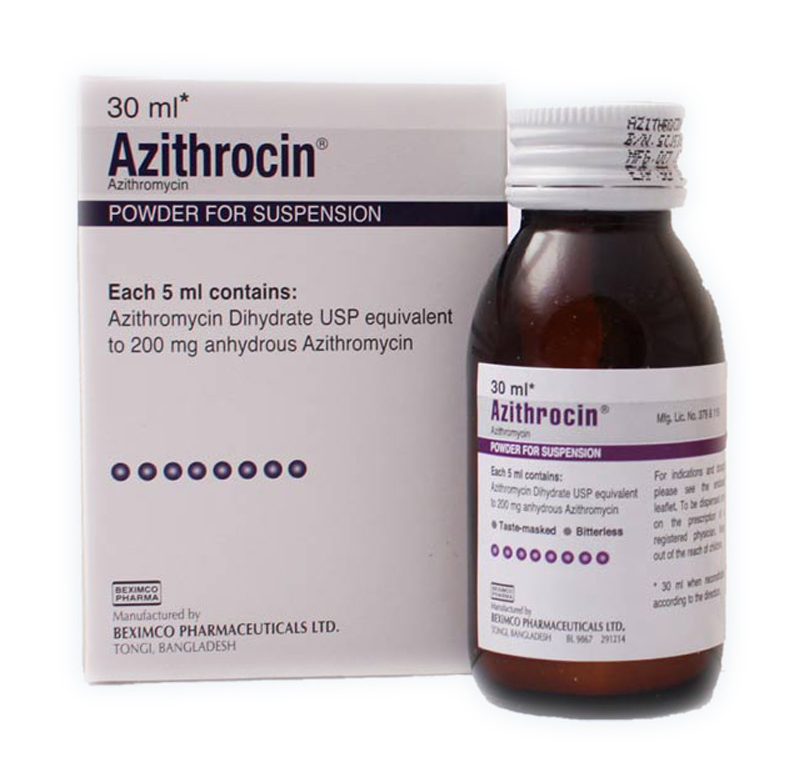Azithrocin® (Azithromycin ) 200mg Suspension (15ml)

ndications of Azithrocin
Azithrocin 15 ml Powder for Suspension is shown for diseases (caused by vulnerable life forms) in lower respiratory tract contaminations counting bronchitis and pneumonia, in upper respiratory tract contaminations counting sinusitis and pharyngitis/tonsillitis, in otitis media, and within the skin and delicate tissue diseases. In sexually transmitted infections in men and women, Azithromycin is shown within the treatment of non-gonococcal urethritis and cervicitis due to Chlamydia trachomatis.
Pharmacology of Azithrocin
Azithrocin is acid-stable and can in this manner be taken orally with no requirement of assurance from gastric acids. It is promptly retained; its retention is more prominent on a purge stomach. Time to crest concentration in grown-ups is 2.1 to 3.2 hours for verbal dose shapes. Due to the tall concentration in phagocytes, azithromycin is effectively transported to the location of contamination. Amid dynamic phagocytosis, huge concentrations of azithromycin are discharged. The concentration of azithromycin within the tissues can be over 50 times higher than in plasma. This is often due to particle catching and tall lipid solubility.
Azithromycin's half-life permits a large single measurement to be managed and however keep up bacteriostatic levels within the tainted tissue for a few days. Taking after a single 500 mg measurement, plasma concentrations of azithromycin declined in a polyphasic design with a cruel clear plasma clearance of 630 mL/min and a terminal end half-life of 68 hours.
Microbiology: Azithromycin acts by binding to the 50S ribosomal subunit of susceptible microorganisms and, thus, interfering with microbial protein synthesis. Nucleic acid synthesis is not affected.
Azithrocin Dosage & Administration
Oral-
Adult:500 mg once daily orally for 3 days or 500 mg once on day 1, then 250 mg once on days 2-5 for 4 days.
For sexually transmitted diseases caused by Chlamydia trachomatis in adults, the dose is 1 gm given as a single dose or 500 mg once on day 1, followed by 250 mg once daily for the next 2 days may also be given.
Children:
10 mg/kg body weight once daily for 3 days for the child over 6 months
200 mg (1 teaspoonful) for 3 days if bodyweight is 15-25 kg
300 mg (1½ teaspoonfuls) for 3 days if bodyweight is 26-35 kg; 400 mg (2 teaspoonfuls) for 3 days if bodyweight is 36-45 kg.
In typhoid fever, 500 mg (2½ teaspoonfuls) once daily for 7-10 days is given.
Azithromycin Injection (For IV Infusion only): The recommended dose of Azithromycin for injection for the treatment of adult patients with community-acquired pneumonia due to the indicated organisms is:
500 mg as a single daily dose by the intravenous route for at least two days. Intravenous therapy should be followed by Azithromycin by the oral route at a single, daily dose of 500 mg, administered as two 250-mg tablets to complete a 7 to 10-day course of therapy. The timing of the switch to oral therapy should be done at the discretion of the physician and in accordance with the clinical response.
The recommended dose of Azithromycin for the treatment of adult patients with pelvic inflammatory disease due to the indicated organisms is 500 mg as a single daily dose by the intravenous route for one or two days. Intravenous therapy should be followed by Azithromycin by the oral route at a single, daily dose of 250 mg to complete a 7-day course of therapy. The timing of the switch to oral therapy should be done at the discretion of the physician and in accordance with the clinical response. If anaerobic microorganisms are suspected of contributing to the infection, an antimicrobial agent with anaerobic activity should be administered in combination with Azithromycin.
The safety and effectiveness of azithromycin for injection in children or adolescents under 16 years have not been established.
Interaction of Azithrocin
In the presence of food or an antacid, azithromycin absorption is reduced. Because of the risk of ergotism from Azithromycin's interaction with the cytochrome P-450 system, it should be avoided in patients receiving ergot alkaloids. Because macrolides raise digoxin and cyclosporin plasma concentrations, caution should be used while taking them together. There have been none thus far.
Contraindications of Azithrocin
Azithrocin is contraindicated in patients extremely touchy to Azithromycin or any other macrolide anti-microbial. Co-administration of ergot subordinates and Azithromycin is contraindicated. Azithromycin is contraindicated in patients with hepatic illnesses.
Azithrocin Side Effects
Azithrocin is a well-tolerated antibiotic with few adverse effects. Nausea, vomiting, abdominal discomfort (pain/cramps), flatulence, diarrhea, headache, dizziness, and skin rashes are among the side effects, which are reversible as the medication is stopped.
Pregnancy & Lactation
pregnancy Category of Azithromycin is B. Creature propagation considers have illustrated that Azithromycin has no proof of hurt to the baby. There are no satisfactory and well-controlled considers in pregnant ladies. Since creature generation ponders are not continuously prescient of human reaction, Azithromycin ought to be utilized amid pregnancy as it were on the off chance that satisfactory options are not accessible. It isn't known whether Azithromycin is discharged in breast drain. So, caution ought to be worked out when Azithrocin is managed to nursing ladies.
Precautions & Warnings
Observation for signs of superinfection with non-susceptible organisms, especially fungus, is suggested with any antibiotic. In patients with renal impairment, there is no need to alter the dose.
Therapeutic Class of Azithrocin
Macrolides.
